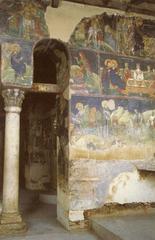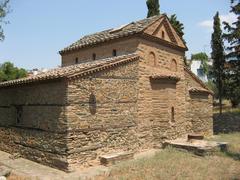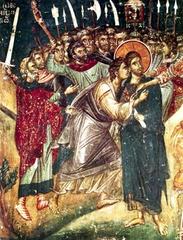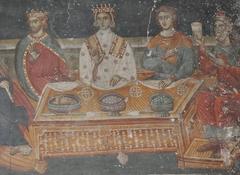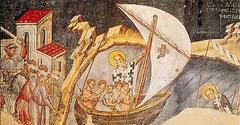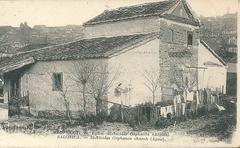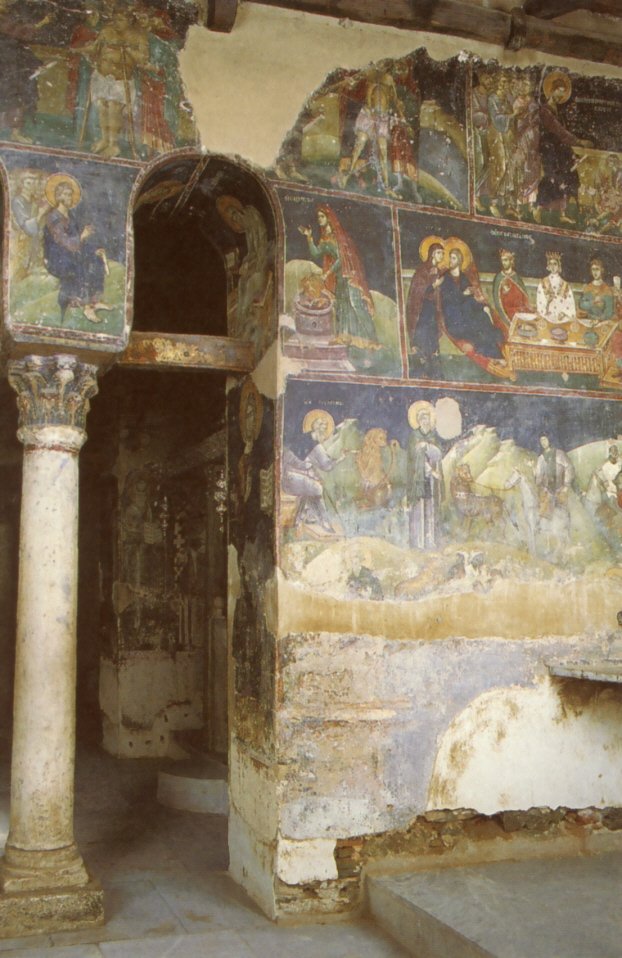
Church of Saint Nicholas Orphanos Thessaloniki: Visiting Hours, Tickets, and Historical Guide
Date: 14/06/2025
Introduction
Nestled in Thessaloniki’s picturesque Ano Poli (Upper Town), the Church of Saint Nicholas Orphanos is a remarkable monument of Byzantine art and spirituality. Built in the early 14th century, the church captivates visitors with its exceptionally preserved frescoes from the Palaiologan Renaissance, its serene atmosphere, and its deep historical ties to both the local Orthodox tradition and the Serbian royal house. As part of the UNESCO-listed Palaeochristian and Byzantine Monuments of Thessaloniki, Saint Nicholas Orphanos represents a unique chapter in the city’s layered history.
This comprehensive guide provides essential information for visitors, including historical context, architectural highlights, practical visiting details, nearby attractions, and travel tips, ensuring a meaningful and enriching experience at one of Thessaloniki’s most treasured sites. For more in-depth resources, see Spotting History, Nikana.gr, and Live the World.
Historical Background and Cultural Context
Origins and Name
Constructed circa 1310–1320, the Church of Saint Nicholas Orphanos served as the katholikon (main church) of a now-lost monastic complex. The epithet “Orphanos” (meaning “orphan” in Greek) is documented from the 17th century onward. While its precise origin remains uncertain, it may refer to the church’s charitable mission, a connection to orphans, or possibly the unknown founder (inthessaloniki.com).
Serbian Royal Patronage
The church’s foundation is closely linked to Serbian King Stefan Uroš II Milutin, who reigned from 1282 to 1321. His marriage to the Byzantine princess Simonida and his patronage of Orthodox sites in Thessaloniki fostered cultural and artistic exchange, reflected in the church’s distinctive frescoes. King Milutin’s philanthropic spirit, expressed through the construction of churches and support for orphans, is believed to have influenced the church’s dedication and decoration (Nikana.gr).
Ecclesiastical and Monastic Significance
During the Ottoman era, Saint Nicholas Orphanos became a dependency (metochion) of the Vlatadon Monastery, allowing it to retain its Christian character and original decoration even as other Thessaloniki churches were converted to mosques. Today, it remains an active Orthodox church and a spiritual sanctuary within the city.
Architectural Features and Artistic Significance
Structure and Materials
The church began as a simple, single-aisled basilica with a wooden gabled roof. Later expansions added aisles on three sides, forming an ambulatory that was also used as a burial site. The masonry features irregular courses of stone and brick, while the use of spolia (reused antique capitals and marble elements) exemplifies Byzantine construction practices (Pemptousia). The modest exterior belies the artistic richness within.
Interior Decoration: The Frescoes
The interior is celebrated for its nearly intact fresco cycles, painted between 1310 and 1320, which cover almost every surface. Highlights include:
- Christological Scenes: The Nativity, Baptism, Crucifixion, and Resurrection.
- Marian Cycle: Annunciation and Dormition of the Virgin.
- Saint Nicholas: Miracles and life events illustrating his role as protector of children, widows, and orphans.
- Saint Gerasimos and Other Saints: Including St. George and Clement of Ohrid, underlining the church’s connections to both Byzantine and Serbian traditions.
The frescoes display the hallmarks of the Thessalonican school of the Palaiologan Renaissance: naturalistic figures, expressive gestures, and advanced use of spatial composition. Their preservation makes Saint Nicholas Orphanos one of the foremost places to appreciate late Byzantine art (Nikana.gr).
Historical Continuity and Preservation
Unlike many Byzantine churches in Thessaloniki, Saint Nicholas Orphanos was never converted into a mosque, ensuring the survival of its Christian iconography. The frescoes were rediscovered and restored in the late 1950s and early 1960s, and ongoing conservation efforts continue to safeguard this cultural treasure. The church’s inclusion in the UNESCO World Heritage List in 1988 recognizes its outstanding universal value (Spotting History).
Visiting Information
Hours and Admission
- Visiting Hours: Open Tuesdays and Thursdays, 8:30 am – 1:00 pm. Hours may occasionally vary due to religious services or restoration work. Always verify before your visit (Nikana.gr).
- Admission: Free entry; donations are welcome to support preservation.
Location and Access
- Address: 1 Irodotou Street, Ano Poli, Thessaloniki 546 30, Greece (Live the World).
- Getting There: Access is primarily on foot via the narrow, cobbled lanes of Ano Poli. The church is not directly reachable by car, and public transport or taxis can take visitors to the district, but expect a short walk to the church.
- Accessibility: The historic site and its surroundings are not wheelchair accessible.
Visitor Etiquette
- Maintain silence and a respectful demeanor.
- Modest attire is required; shoulders and knees should be covered.
- Non-flash photography may be permitted—always ask staff before taking photos of the frescoes.
- There are no restroom or visitor facilities on-site; plan accordingly.
Highlights and Nearby Attractions
Church Highlights
- Frescoes: Extensive cycles depicting biblical scenes, saints, and miracles.
- Architecture: Single-aisled basilica with later ambulatory, marble iconostasis, and reused antique capitals.
- Atmosphere: Peaceful, contemplative, and evocative of Byzantine spirituality.
Nearby Sites in Ano Poli
- Vlatadon Monastery: A short walk away, offering panoramic city views.
- Byzantine Walls and Trigoniou Tower: Thessaloniki’s ancient fortifications.
- Byzantine Bath: A rare surviving example of medieval public baths.
- Other Byzantine Churches: Prophet Elijah, Hosios David, and Saint Demetrios, each with their own historical and artistic riches.
- Cafés and Taverns: Enjoy Macedonian cuisine in the charming lanes of Ano Poli.
Practical Tips
- Best Time to Visit: Spring and autumn provide pleasant weather and soft natural light for viewing frescoes.
- Footwear: Wear comfortable shoes for cobblestone streets and steps.
- Language: Basic English may be spoken by staff, but gestures and politeness go a long way.
- Guided Tours: The church is included in several walking tours of Thessaloniki’s UNESCO monuments.
Frequently Asked Questions (FAQs)
Q: What are the visiting hours of the Church?
A: Typically Tuesdays and Thursdays, 8:30 am to 1:00 pm. Confirm ahead as hours can change.
Q: Is there an entrance fee?
A: No, admission is free; donations are appreciated.
Q: Are guided tours available?
A: The church is featured in various walking tours of Ano Poli and the UNESCO monuments.
Q: Is the site wheelchair accessible?
A: No, due to the historic structure and cobblestone setting.
Q: Can I take photos inside?
A: Non-flash photography may be allowed, but always ask staff before photographing frescoes.
Visuals and Interactive Resources
Enhance your visit with virtual tours, high-resolution images, and maps available on official tourism and cultural heritage websites. These resources highlight the church’s location, architectural details, and frescoes, supporting both on-site and virtual exploration.
Conclusion
The Church of Saint Nicholas Orphanos offers an intimate journey into Thessaloniki’s Byzantine past. Its unique combination of historical continuity, Serbian-Byzantine influences, and breathtaking frescoes make it a must-see for history buffs, art lovers, and pilgrims alike. With free admission, a peaceful setting, and proximity to other significant monuments in Ano Poli, this church is a highlight of any Thessaloniki itinerary.
For up-to-date information, travel tips, and audio guides, download the Audiala app and follow us on social media. Let the spiritual and artistic legacy of Saint Nicholas Orphanos inspire your exploration of Thessaloniki’s cultural treasures.
